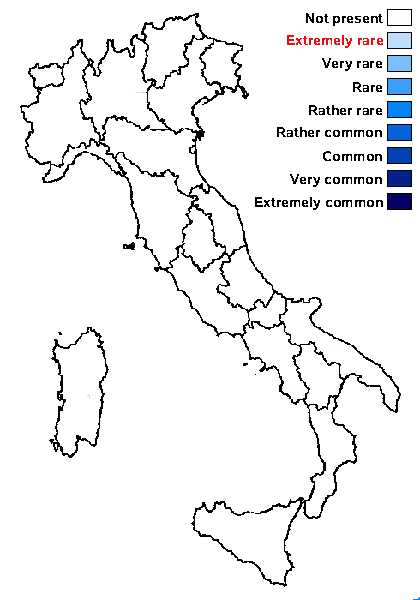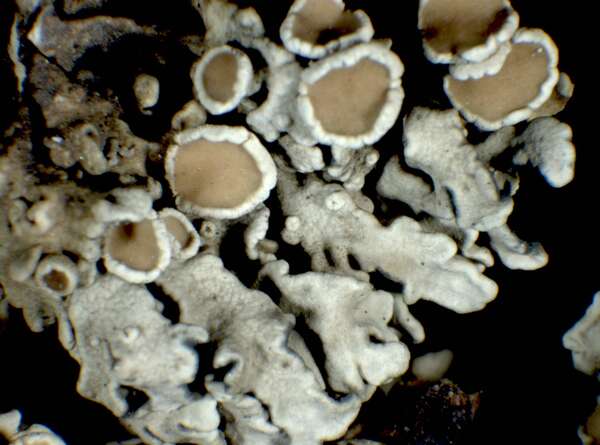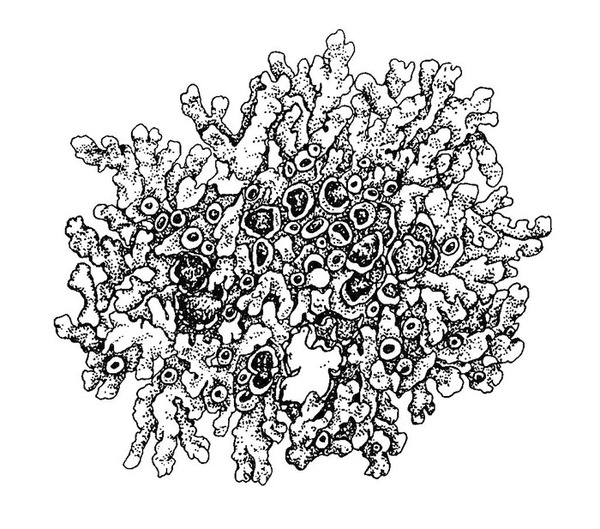Protoparmeliopsis achariana (A.L. Sm.) Moberg & R. Sant.
in Santesson & al., Lichen-forming and lichenicolous fungi of Fennoscandia: 268, 2004. Basionym: Lecanora achariana A.L. Sm. - Monogr. Brit. Lich., 1: 261, 1918.
Synonyms: Lecanora cartilaginea (Ach.) Ach.
Distribution: C - Sar (Nöske 2000).
Description: Thallus crustose-placodioid to subfoliose, whitish grey, grey-green to pale yellowish green, epruinose or rarely slightly pruinose, very loosely attached, forming distinct, more or less orbicular to irregular, often confluent rosettes, the lobes flat to slightly convex, attached only in the central part of thallus, otherwise free, often ascending in peripheral parts, 1-2 mm wide, contiguous to often overlapping, especially in central parts. Lower surface whitish. Apothecia lecanorine, usually crowded in central parts of thallus, 1-3 mm across, strongly constricted at base to substipitate, with a flat, pale brown, epruinose disc and a prominent, raised, persistent, smooth to usually crenulate thalline margin. Epithecium brown, with an epipsamma of very small crystals; hymenium colourless, 50-70 μm high, I+ blue; paraphyses mostly simple; hypothecium colourless. Asci 8-spored, elongate-clavate, very thin-walled, with a K/I+ blue, tall tholus penetrated by a faintly amyloid apical cushion, the wall K/I-, surrounded by a K/I+ blue outer layer, Lecanora-type. Ascospores 1-celled, hyaline, ellipsoid, 10-16 x 4-6 µm. Photobiont chlorococcoid. Spot tests: cortex and medulla K-, C-, KC-, P-, UV-, or medulla (very rarely) K+ yellow turning red. Chemistry: upper cortex with usnic acid; medulla with zeorin and unknown triterpenoids.Note: on exposed siliceous rocks, usually on the top of large boulders, sometimes overgrowing bryophytes; the only Italian station is from the summit of the Gennargentu Massif, where the species is fairly abundant. However, the species is also known from the Alps, outside the Italian territory, and should be looked for there.
Growth form: Crustose placodiomorph
Substrata: rocks
Photobiont: green algae other than Trentepohlia
Reproductive strategy: mainly sexual
Most common in areas with a humid-warm climate (e.g. most of Tyrrenian Italy)
Commonnes-rarity: (info)
Alpine belt: absent
Subalpine belt: absent
Oromediterranean belt: extremely rare
Montane belt: absent
Submediterranean belt: absent
Padanian area: absent
Humid submediterranean belt: absent
Humid mediterranean belt: absent
Dry mediterranean belt: absent

Predictive model
Herbarium samples
Growth form: Crustose placodiomorph
Substrata: rocks
Photobiont: green algae other than Trentepohlia
Reproductive strategy: mainly sexual
Most common in areas with a humid-warm climate (e.g. most of Tyrrenian Italy)
Commonnes-rarity: (info)
Alpine belt: absent
Subalpine belt: absent
Oromediterranean belt: extremely rare
Montane belt: absent
Submediterranean belt: absent
Padanian area: absent
Humid submediterranean belt: absent
Humid mediterranean belt: absent
Dry mediterranean belt: absent

Predictive model
| Herbarium samples |
 INDEX FUNGORUM
INDEX FUNGORUM
 GBIF
GBIF






